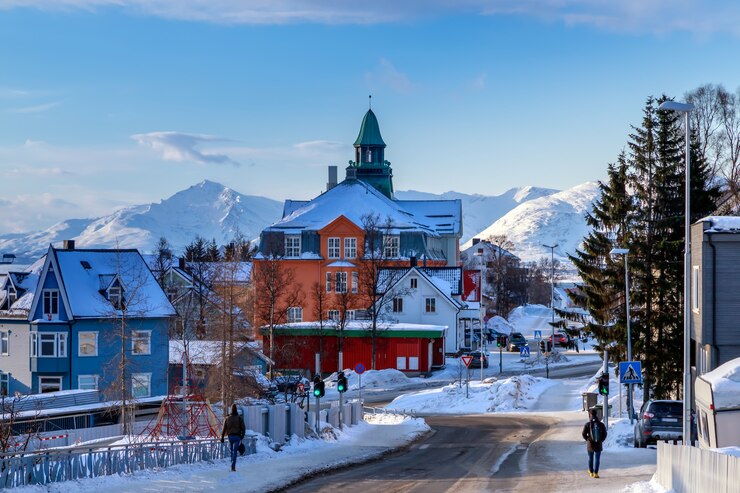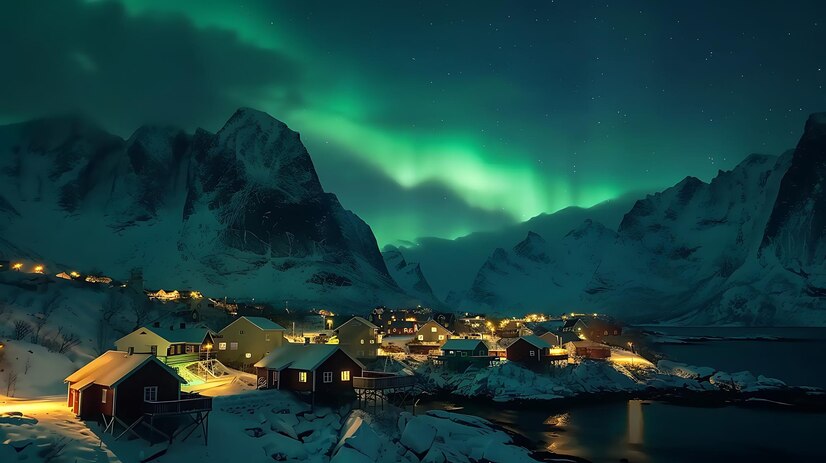Located in northern Norway, in the Arctic Circle, Tromso is a perfect destination to visit at this time of year. Often considered one of the best places in the world to see the Northern Lights, this region has a lot to offer visitors.
From the vibrant city of Tromso with its vibrant cultural life, to the remote and stunning Arctic landscapes, or the famous Norwegian fjords, there are plenty of reasons to put Tromso at the top of any traveler’s bucket list.
Indeed, geography has been kind to Tromso. Situated on the island of Tromsoya, in a strait in northern Norway, the city is surrounded by the sea, with the Tromsoysundet fjord, other islands and fjords nearby.
From September to March, the months when there is a greater chance of seeing the Northern Lights, Tromso becomes the capital of the Northern Lights and welcomes many visitors who head to polar latitudes in the hope of observing one of the most spectacular natural phenomena on the planet.
Winter in Tromso is particularly magical. From the beginning of December to mid-January, the mythical polar nights are experienced, with less than an hour a day of pale, blue light that can only be experienced at these latitudes.
Read More: Best Places to Visit in Netherlands
It was precisely at this time that I visited Tromso, at the turn of the year. I can therefore confirm that it is a unique experience. And that the lack of sunlight is not at all an obstacle to making the most of the region. On the contrary, it maximises the possibility of seeing the Northern Lights because the night is almost constant.
I recommend spending some time strolling through the city centre, which has a wide range of shops, restaurants and cafés. At Christmas time, it looks particularly beautiful with its festive decorations. The port area offers fantastic views of the sea and the surrounding mountains.
There is also a wide range of cultural activities to fill your days in Tromso while you wait for the Northern Lights to light up the skies. The Polar Museum is very interesting, offering information about life in this remote part of the world, while also providing an overview of the nature and culture of Lapland. At Polaria you can learn more about Arctic marine life.

Be sure to cross the bridge that connects Tromso city centre to the other side of the city. Located just off the bridge, the Arctic Cathedral (Ishavskatedralen) is a must-see. Opened in 1965, it is an architectural landmark in Tromso with its distinctive structure that stands out against the city skyline.
Another must-do experience in Tromso is to take the Fjellheisen cable car to enjoy the best views. The cable car climbs to the top of Storsteinen mountain, 421 metres above sea level. The observation deck at the top station offers spectacular panoramic views of Tromso and the surrounding mountains, fjords and islands.
There are so many activities typical of the Arctic regions available in the city’s surroundings that it will be difficult to choose. From snowmobiling to reindeer or husky sleigh rides, from snowshoeing to visits to Sami farms to learn more about the lifestyle of the Lappish people who have inhabited this region for thousands of years, there is a wide range of options.
Also Visit: Canada Startup Visa
Visiting Tromso is also a unique opportunity to explore the Norwegian fjords, one of the calling cards of this Scandinavian country. It is worth renting a car or taking a day tour to visit places like Kvaloya, the fifth largest island in Norway known for the typical local fishing village of Sommaroy, and its dramatic scenery with deserted icy beaches. Along the way, with a bit of luck you may see whales on the horizon in the open sea, reindeer, moose and other animals typical of these polar regions, framed by breathtaking natural landscapes.
But the most sought-after experience in Tromso is undoubtedly seeing the Northern Lights. This phenomenon is caused by the impact of solar wind particles entering the atmosphere, channeled by the Earth’s magnetic field, creating a spectacle of colorful lights that dance across the sky.
To be able to see the Northern Lights, a set of circumstances must come together favorably: heading North, preferably above the Arctic Circle, clear and dark skies, solar activity and, of course, some (or a lot) of luck!
There are apps that allow you to track the level of activity of the Northern Lights and calculate the probability of seeing them. If the level of activity is low, you will still be able to see faint auroras, but when the level of solar activity is high and the weather conditions are ideal, you will be able to witness the most stunning natural spectacle in the world.
Auroras are usually green, but occasionally they can be visible in different colors such as blue, purple or pink. This depends on the density and composition of the atmosphere, as well as the altitude of the collision when solar particles hit the Earth’s atmosphere.
Also Read:
US Visa
Things to do in Bangkok
The good news is that we are currently experiencing a cycle of intense solar intensity, which will peak in 2024 and 2025, and the ideal conditions for particularly strong Northern Lights are expected to be in place. Perhaps this is the ideal time to book that long-awaited trip and finally see the Northern Lights.
Blog Forbes Daily: Join the Blog Forbes and get our best stories, exclusive reports and important analysis of the business daily, News, Travel, Health, Lifestyle and more.

